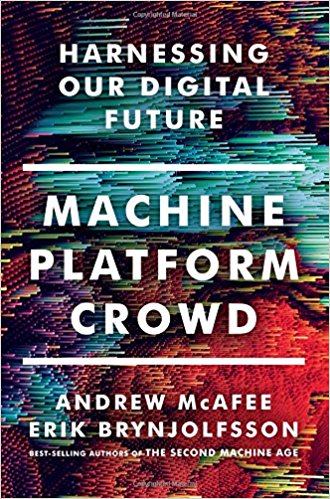You have /5 articles left.
Sign up for a free account or log in.
 Machine, Platform, Crowd: Harnessing Our Digital Future by Andrew McAfee and Erik Brynjolfsson
Machine, Platform, Crowd: Harnessing Our Digital Future by Andrew McAfee and Erik Brynjolfsson
Published in June of 2017
The unifying theme Machine, Platform, Crowd: Harnessing Our Digital Future is that we are underestimating the pace of technologically driven economic change - and that these changes will concentrate advantage amongst an ever narrowing segment of companies and individuals.
Could it be that the same technological forces that have concentrated economic power in a few digital platform companies (Google, Amazon, Facebook), while devastating large parts of other information industries (news, music, publishing etc.), will also end up concentrating advantage amongst a shrinking number of college and universities?
Could technologically driven change also occur at a faster rate and a larger scale than today’s postsecondary incumbents realize, leading a widespread destabilization of the higher ed industry?
The underlying technological shifts detailed in Machine, Platform, Crowd will be familiar. They include the interaction effects of advances in artificial intelligence and machine learning, with the growth of interconnected digital networks (the mobile internet and the internet of things). Platform companies, such as Uber (transportation) and Amazon (retail) and Airbnb (hospitality), can concentrate market advantage by investing in data analysis and user experience (UI), without having to sink resources into hard physical assets. (Uber owns no cars, Airbnb no hotel rooms, etc.)
McAfee and Brynjolfsson see the weak signals such as Google’s AlphaGO A.I. now able to defeat any human GO player - a development that occurred at a faster rate than almost every A.I. researcher had predicted - as indicators of much larger structural economic changes to come.
Machine, Platform, Crowd is full of examples of traditional industries and long-successful companies that failed to anticipate and then change in the face of the digitization of the economy. Newspaper print ad revenue has fallen from $45 billion in 2000 to $16.4 billion in 2014. While digital advertising did grow in this time, it only brought in $3.5 billion. This drop in revenues has resulted in a decline of newsroom employees from over 56,000 in 2000 to under 33,000 in 2014.
Other examples that McAfee and Brynjolfsson cite as examples of technologically based disruption including everything from the hollowing out of middle class jobs (as wages and productivity growth have been decoupled), to the disappearance of retail stores. From 2005 to 2015 the number of indoor shopping malls declined by 20 percent. 2007 was the first year in 50 that no indoor shopping mall was opened.
The point that Machine, Platform, Crowd makes is that the forces that saw companies like Kodak implode - going from a market capitalization $31 billion in 1997 to bankruptcy in 2012 - are just now starting to gain momentum.
Could the higher ed industry find itself in a similar situation as the recorded music industry?
Revenues from recorded music declined from $27 billion in 1999 to $15 billion in 2014. With this decline in revenue came consolidation and concentration. In 2002 there were 5 major music labels. Today, there are only 3 (Universal, Sony, and Warner), and collectively the account for 85% of music distributed in the U.S.
How many colleges are immune from the fate of Newsweek, a publication that went from a circulation of 3.3 million in 2007 to needing to cease print publication in 2012?
McAfee and Brynjolfsson don’t turn their accelerating technological disruption lens on higher ed - but perhaps we should.
It has become super uncool amongst the edtech crowd to even use the word “disruption”. (Also “innovation” - but that is another story). We should not get hung up on the word. Instead, we should ask if diffusion of digital economics (free, perfect, and instant), the rise of platform industries, and the growing power of data driven AI will make traditional postsecondary business models unstable?
The forces discussed in Machine, Platform, Crowd did not so much eliminate traditional industries - but concentrate wealth and power in these industries amongst a few players.
The winners of the decline in the recorded music industry and newspapers was Facebook and Google - as ad revenue moved to these platforms. The winner in the disappearance of all those shopping malls will be Amazon.
What can we do, if anything, to avoid a further concentration of advantage amongst a few institutions of postsecondary learning - as large numbers of colleges struggle with structural deficits and the risk of closing?
If we take the thinking in this book seriously, then it is hard to avoid the conclusion that incremental change amongst incumbents will not be enough to guard against a technologically driven fragility for many institutions of higher learning.
Machine, Platform, Crowd is a book that should be read and discussed by higher ed people with an eye towards understanding how the ideas discussed in the book might apply to our own industry.
Assuming that the higher ed industry is not a zero sum game, and that we all benefit from a diverse ecosystem of economically healthy postsecondary institutions, then it the case that all of us have a stake in the resilience of individual colleges and universities.
Can we apply the lens that McAfee and Brynjolfsson bring to making sense of the future of companies to the future of colleges?
What are you reading?




